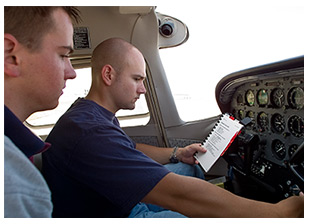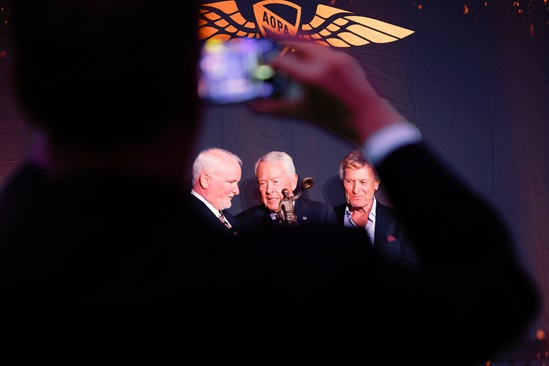Training Tips |
Completing the appropriate checklist
A flight instructor and a student pilot are reviewing for the student’s private pilot flight test. The discussion has turned to landings in the student’s trusty trainer, a Cessna 150 Commuter. "Tell me: When do you retract the flaps after landing?" the CFI inquires. "Flap retraction is on the after-landing checklist," responds the student, adding, "And you always tell me not to distract myself by putting my head down to raise the flaps while the aircraft is still rolling on the runway, because I could lose directional control." Lesson well learned! But now the instructor asks the student if there are any exceptions to that safety-minded, distraction-fighting operating method. There is no reason for a ground session in preparation for a checkride to be a closed-book exercise. Knowing where to find necessary information—weather, notams, aircraft performance, regulations, airworthiness, and other maintenance subjects—is the mark of a qualified pilot, after all. So the student pilot looks up the answer in the pages of the aircraft's pilot's operating handbook. There, among the checklists for normal procedures, the trainee points out the checklist for a short-field landing: It calls for brakes to be applied heavily, followed by flap retraction. Why retract the Cessna’s flaps so soon after touchdown? The chapter's section on amplified procedures explains what to do immediately after touchdown—and why: "For maximum brake effectiveness, retract the flaps, hold full nose-up elevator, and apply maximum brake pressure without sliding the tires." Overlooking the early flap-retraction step is a common error. Whether the lapse reflects task saturation—after all, a short-field landing is a pretty demanding operation—or the need for better checklist awareness, the omission can cause an aircraft to use more runway than necessary during deceleration. That would put the landing at odds with the practical test requirement for a short-field landing, which dictates that the aircraft "stop in the shortest distance consistent with safety." It would also suggest that the test applicant did not comply with task objective 13: "Completes appropriate checklist." Understanding the why of the items on your checklists will help you remember steps required to meet a flight operation's performance goals. But hold on, we're not done: The Cessna 150's after-landing checklist still needs attention, once the aircraft is taxied clear. What does the “appropriate checklist” for your aircraft say? CORRECTION: In the Aug. 9 issue of AOPA ePilot: Flight Training Edition, we incorrectly described a part of the private pilot practical test standards for short-field landings. An applicant must touch down at or within 200 feet beyond a specified point. Training ProductsDeohako iPad mini yoke mount now availableThis new iPad yoke mount, available from AOPA Strategic Partner Aircraft Spruce, is a compact aviation mounting system that mounts to the yoke quickly and economically. Use the yoke mount while flying to navigate with an electronic flight bag or call up your pre-loaded airport diagram, approach plates, standard terminal arrival routes (STARs), departure procedures (DPs), and more. The cost is $70. Learning to fly in the cloudsTeaching Confidence in the Clouds offers real-life application of computer desktop flight simulators and flight training devices as they relate to current methods of instrument training. Since they were first adopted in 1997, FAA-approved desktop flight simulators have been an effective means to train students. The scenario-based training concepts, training assignments, and instructor tips included in this book will be a valuable resource for flight instructors and help reduce the number of hours needed to complete an instrument training program. The cost is $9.31. Note: Products listed have not been evaluated by ePilot editors unless otherwise noted. AOPA assumes no responsibility for products or services listed or for claims or actions by manufacturers or vendors. Final ExamQuestionIs it necessary, when departing from a nontowered satellite airport that lies within Class D airspace, to contact the tower of the primary airport? AnswerYes; FAR § 91.129(C)(2)(ii) specifies the correct procedure for this situation. It reads,"From a satellite airport without an operating control tower, you must establish and maintain two-way radio communication with the ATC facility having jurisdiction over the Class D airspace area as soon as practicable after departing." In this case the primary airport tower is the controlling authority with jurisdiction over the Class D airspace. Got a question for our technical services staff? Contact AOPA. Don't forget the online archive of "Final Exam" questions and answers, searchable by keyword or topic. |



